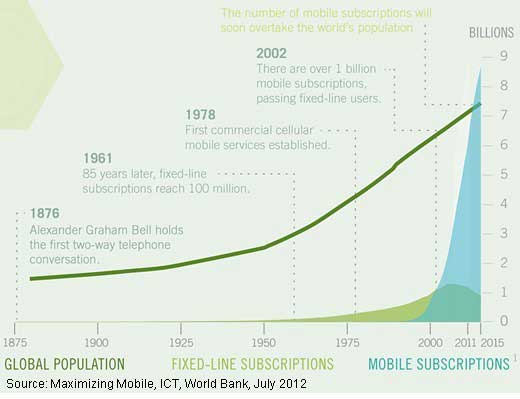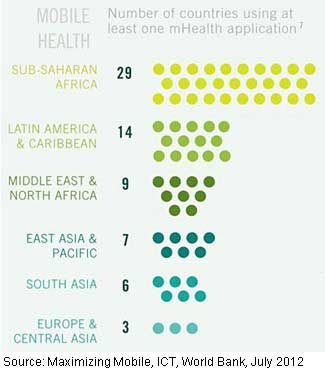As of early 2012, more than six billion mobile subscriptions were in use around the world (pre-paid and post-paid), providing mobile access for more than three-quarters (75%) of the world's inhabitants, according to a report by the World Bank.
Mobile phone subscriptions have grown more than eightfold over the past 10 years (up from 0.7 billion in 2000), with the developing world driving much of the growth: As of 2010, developing countries accounted for 77% of worldwide mobile subscriptions, and high-income countries accounted for 23% of subscriptions. That ratio is a dramatic reversal from penetration levels recorded 10 years earlier:

Below, additional findings from the report titled "Maximizing Mobile," published by the World Bank's Information and Communications Technologies (ICT) office.
The ownership of multiple subscriptions is becoming so common that the number of worldwide subscriptions is expected to surpass the human population (now close to 7 billion) by the end of 2013:

Importantly, the near ubiquity of mobile is offering new economic opportunities for the developing world.
For example, the citizens of 74% of the world's countries now use at least one mobile money app, up from 2% in 2001.
In addition, there are public-health related benefits to mobile access: 29 of the countries in Sub-Saharan Africa use at least one mobile health app (there are 47 countries in Sub-Saharan Africa in total), and 14 of the countries in Latin America and the Caribbean use such apps:

"The mobile revolution is right at the start of its growth curve: mobile devices are becoming cheaper and more powerful while networks are doubling in bandwidth roughly every 18 months and expanding into rural areas," said Tim Kelly, lead ICT policy specialist at the World Bank and one of the authors of the report.
"Government support is needed to develop sound business models, foster ICT skills, and ensure that the infrastructure is in place and affordable," explained Kelly.
Countries around the world are taking advantage of mobile potential, with the following examples cited in the report:
- In India, the state of Kerala's mGovernment program has deployed over 20 apps and facilitated more than 3 million interactions between the government and citizens since its launch in December 2010.
- Kenya has emerged as a leading player in mobile for development, largely due to the success of the M-PESA mobile payment ecosystem. Nairobi-based AkiraChix, for example, provides networking and training for women technologists.
- In Palestine, Souktel's JobMatch service is helping young people find jobs. College graduates using the service reported a reduction in the time spent looking for employment from an average of twelve weeks to one week or less, and an increase in wages of up to 50%.
[1] ITU (International Telecommunication Union) estimates, 2010.
[7] Adapted from GSMA (Groupe Speciale Mobile) mHealth Tracker, 2012.
About the report: Findings are from the report [pdf] titled "Maximizing Mobile," authored by Tim Kelly and Michael Minges of the World Bank, and published by the World Bank on July 17, 2012.



